Spanish Architecture – Examples of Famous Architecture in Spain
Spanish architecture has developed over the centuries by adapting many other European forms into its own unique versions of those styles, and this article will explore those adaptations throughout European history. We’ll have a look at how this architecture developed over time, and how it has become such a major area for innovation in the modern day. Keep reading to learn more about Spanish architecture!
Contents
A Look at Spanish Architecture
The history of Spanish architecture reflects much of the history of European architecture as a whole. The architecture of Spain led to the development and alteration of many mainstream forms of architecture that were given a Spanish spin as they grew and evolved throughout the country and beyond. So, let’s have a look at that history, from the earliest days imaginable to the present.
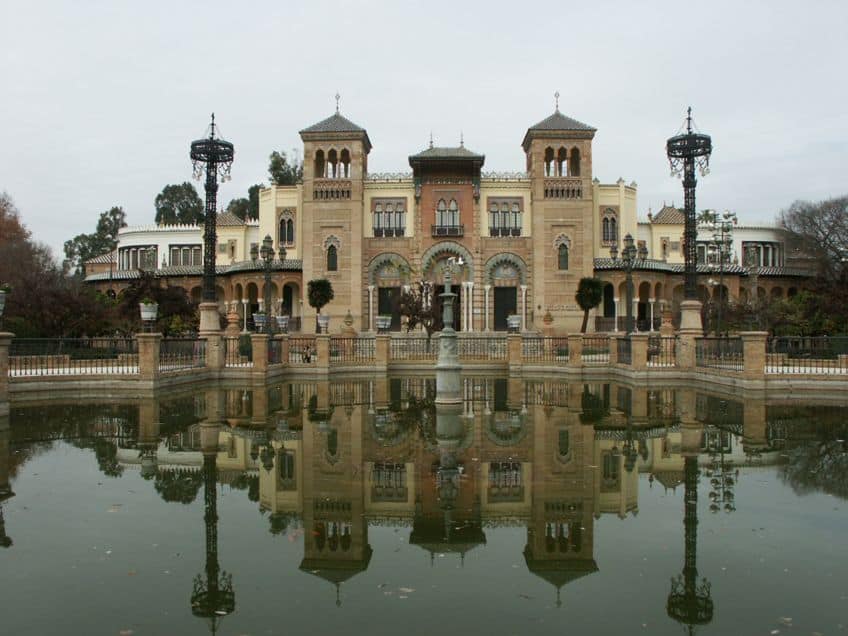
The Early Days of Spanish Architecture
The earliest days imaginable are the days long before civilization as we know it started. The earliest instances of architecture in Spain are from the Stone Age around 4000 BCE. These earliest instances are what could be deemed architecture including burial mounds, megaliths, and table-like pilgrimage and prayer structures known as dolmens. These ancient sites do not provide us much of a view of the specifics of Spanish architecture as they predate the nationalities of this description.
These kinds of structures continued through the Bronze Age. The kinds of groups that led to these exceedingly early attempts at architecture were the Celts and the Visigoths who inhabited the area. This would continue for several thousand years until the eventual Roman conquest of the area in 218 BCE.
The Romans, who were obviously known for their conquering ambitions around the world, did exactly the same with the Spanish areas they conquered. They began cities and romanized the culture around them. The earliest origins of practically all of Europe are intrinsically tied to Ancient Roman culture, and Spain is simply another such place. This rapid urbanization led to the development of cities like Cordoba and Tarragona. The vast road networks that the Romans constructed allowed for the emergence of a new Spanish civilization based on Roman principles. In fact, some of these Ancient Roman structures still actually stand and function to this very day. The Tower of Hercules is one such structure.

The Tower of Hercules functions, to this day, as the oldest working lighthouse on the planet, and it is an impressive structure using Roman architectural methods. It is not known for having any kind of Spanish-style architecture attached to it, but it does show the origins of Roman methods in the country, like concrete. This Classical Age of architecture in the country would slowly shift as Spain entered into the more Christian and Islamic influences that would lead to a more decidedly Spanish architectural style.
The Christian and Islamic Influences on Spanish Architecture
The influences of religions have always had a major impact on cultures around the world, and Spain is no different. The emergence of the Pre-Romanesque in the 7th century CE would solidify this. The age of the Romans themselves had fallen away, but in the meantime, the Holy Roman Empire had developed. This brought with it the use of Christian structures. During this time period, many churches and similar buildings were constructed around the country, and they developed with the use of architectural methods like arches and lattices that would come to dominate these kinds of styles. The iconography of knights and chivalry would also populate these structures, but the Pre-Romanesque would, obviously, eventually merge into the Romanesque by the 10th century CE.
The Romanesque style of architecture is where we start to see a far more Spanish style beginning to develop. The structures built during this time include a rather basic and unadorned architecture that made use of more symmetrical constructions with bulky walls, large towers that loomed above all, and rounded arches. These kinds of structures were designed to be incredibly sturdy.
This was also the time in which many monasteries were constructed, and the influences brought on by these monks would go on to have a lasting influence as the adoption of a functional form of architecture would take precedence. To the monks, it was important that decadence not be celebrated, so style over substance was not of interest to them in the structures that they constructed. This is also where things like the Cistercian architecture emerged, which is a smaller offshoot of architectural design that merged the wilting Romanesque with the burgeoning Gothic style.

The transition into Gothic architecture was mirrored by countries across Europe. These large and complex designs, such as the cathedrals, became increasingly prevalent form across the country. The development of Gothic Spanish architecture spread throughout the country as a form of High Gothic with its heavily pointed style, a style that could soon be found all over Spain. However, one cannot move on from here without also considering the influence of Mudéjar architecture. This form of architecture arose from the Moorish people who did not convert to Christianity after the Christian reconquest of part of the country. The Mudéjar were Islamic people who brought those influences with them.
The Mudéjar architecture in the country led to the development of buildings that adopted intricate geometric shapes, glazed tile mosaics that could be found adorning structures, and octagonal towers.
There were many synagogues and mosques developed during the time of the Mudéjar’s influence, and this style of architecture would go on to have long-lasting effects on the country as a whole that would shift it from a mirror of much of European architecture into its own forms. However, that does not mean that Spanish architecture developed entirely on its own from here. The country was still one of the European nations, and as such, it was influenced by other sources. Much like practically all of Europe, Spain would see significant influence from Italy during the Renaissance and beyond.
The Italian Influences on Spanish Architecture
The Renaissance may have begun in Florence, Italy, but it did not remain there for long. It is one of the most significant periods of time as its influence spread across Europe. The various Gothic buildings that had once been so prominent were often converted and adapted to meet with the new Renaissance style and this actually led to the development of the Spanish style known as the Plateresque.
The Plateresque made use of highly decorated designs, heavily ornate façades, and complex silver work. These styles would together lead to elaborate designs, classical Roman influences, symmetrical presentation, and abundant levels of continued Christian influence. This finally led to the Baroque style.
Once again, the Baroque style made its way into Spain through Italy. Unlike Renaissance architecture, the Baroque style was focused on a more detailed form. The Baroque structures in the country featured many adornments and embellishments, lavish statues, and beautiful designs. These would merge with the decidedly Spanish form of it known as the Churrigueresque style. The Churrigueresque style is incredibly lavish in its design. Some of the best instances of this particular form can be found in cities like Salamanca. It was highly detailed and made use of fancy decoration meant to be utterly gorgeous in its presentation. However, this would give way to the Herrerian style.
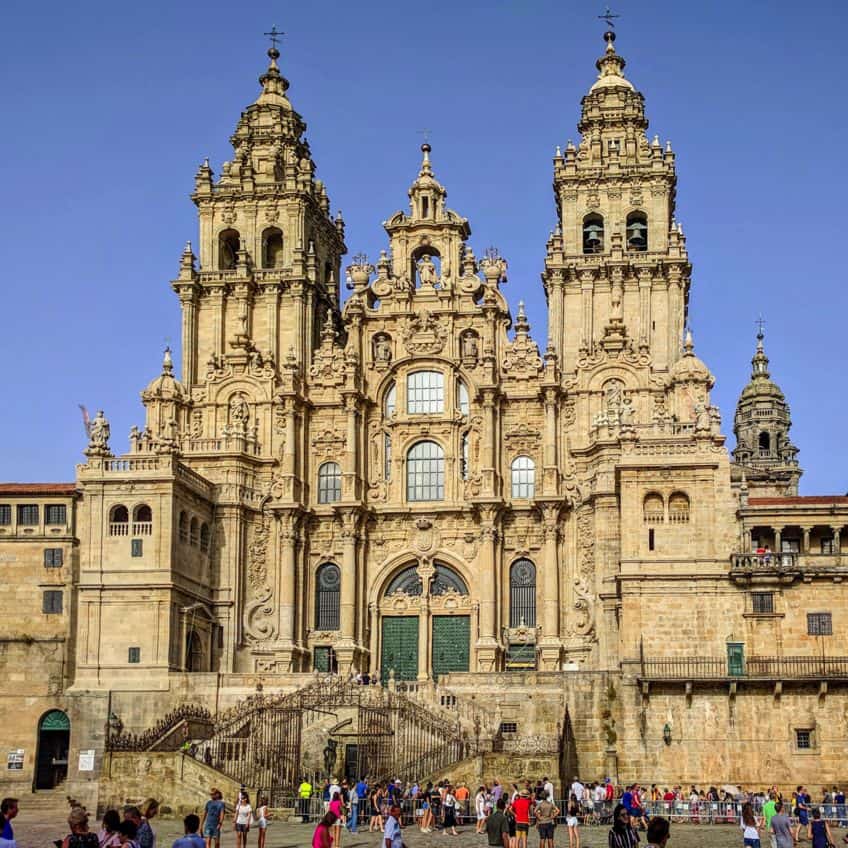
The Herrerian style is far less ornate. It makes use of more simplified geometric designs and rather clean walls with little to no decoration of any real kind. However, this form would be swept up in the Neoclassical form that would come to dominate the western world’s architecture for centuries to come. The Neoclassical era arose, like the others, in Italy and France and spread throughout Europe. Spain took on this form like it did the others, and the use of highly symmetrical designs and a more simple, efficient, and functional form took precedence. It was, as the name suggests, a revival of Roman-style architecture, and it made use of far cleaner, clearer designs that would go on to inspire the architecture of the more modern eras of the world.
The Arrival of Modern Forms in Spanish Architecture
The arrival of modernism throughout the world in the 19th century would bring with it various designs that were inspired by prior cultures and civilizations. The influence of the past led to Neo-Gothic and Neo-Romanesque styles that would aid in the construction of buildings like the Sagrada Família, which will be discussed below.
These forms would continue with more minimalist and regionalist architecture that adhered to the past while creating new forms. One of the major modern influences of Spanish architecture is in the Spanish Colonial Revival style that has become prevalent in recent years in the Americas especially.
Spanish architecture has developed into its own form, and Spain has become a leader in contemporary architecture, as will be shown below. The history of Spanish architecture may have been informed by other cultures, but it developed into its own form, and much of the most famous architecture in Spain shows that reality.
A Few Famous Spanish Buildings
We’ve had a look at the history of Spanish architecture, but we haven’t had much of a look at the actual structures that were built in the country. So, let’s put a stop to that and have a look at some of these structures. Below, you’ll learn about five such structures that range from adaptations of Ancient Roman architecture all the way through to the present.
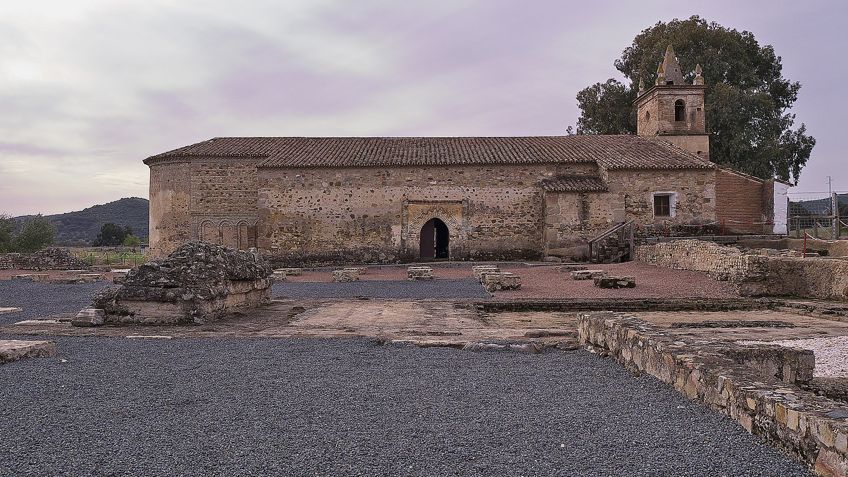
Alcázar of Segovia (1120 – 1587) in Segovia
| Architect | Unknown |
| Date Constructed | 1120 – 1587 |
| Function | Museum |
| Location | Segovia, Spain |
The Alcázar of Segovia represents some of the oldest remaining architecture in Spain, but this castle-palace is somewhat difficult to determine exactly because it started its life as a Roman structure that was then extensively reworked and redesigned to become what it is today. The original foundations of the Roman structure were all that were left by the time the reconstruction commenced. So, you could also argue that the building, or some version of it, existed all the way back in the 1st century CE, but we’re going to choose to view the later Spanish structure as the origins of what it is today.
The Spanish version of this structure was built under the Berber Almoravid dynasty, but that particular era is hardly studied as very little of its art and architecture has managed to survive to the present day. However, this classic castle, with its Herrerian-style courtyard, drawbridge, keep, and moat is a stunning example of this era.
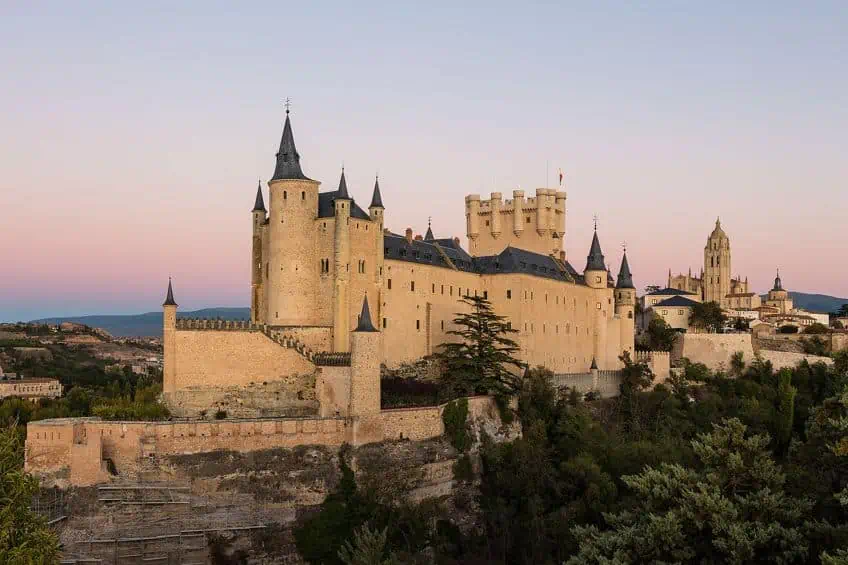
The interior was designed to be the pinnacle of luxury and beauty, and numerous Mudéjar painters and artists were hired for the job. By the end of the castle-palace’s construction, it had a design that emulated the bow of a ship, and it came to be occupied by a variety of royals over the centuries. In the first half of the 15th century, there was a new addition. The Tower of John II of Castile was constructed within this gorgeous example of Spanish-style architecture. The tower was designed in the Spanish Gothic style, but various influences came from Islamic art. You can still visit the castle to this day, but things are a little different now as it isn’t exactly a military installation anymore. The castle palace is now home to a museum, but there is also a military archive building on the property. One can visit and experience the majesty for oneself.
Sagrada Família (1882 – 2026) in Barcelona
| Architect | Antoni Gaudí (1852 – 1926) |
| Date Constructed | 1882 – 2026 (Estimate) |
| Function | Church |
| Location | Barcelona, Spain |
The Sagrada Família is not a cathedral. That may be the very first thought that you’d have upon seeing it, but it is not actually associated with the Catholic church, although it was declared a minor basilica by Pope Benedict XVI. The reason that this cathedral-looking structure is not a cathedral is that it is privately funded and does not receive any oversight from the church. The building is also unfinished. Because the Sagrada Família is entirely privately funded through donations, work on the structure has been intermittent through the years. It had to stop construction at many points. It even had to slow construction because of the Covid-19 pandemic. It was meant to be completed by 2026, which would have been the centenary of Antoni Gaudí’s death. He was the architect of this magnificent and important piece of Spanish architecture history.
Gaudi was not the original architect, but once he became the architect, he radically changed the plans and set about doing something utterly unique with this church-inspired building. He has since become one of the most famous Spanish architects because of his contributions to famous architecture in Spain.

Gaudí would take over from the original Gothic Revival style and would instead use his own blend of Catalan Modernism, Spanish Late Gothic, and Art Nouveau architecture. This blend produced one of the most beautiful Spanish buildings in the world, but it also proved to be immensely difficult to do, and he saw less than a quarter of the structure finished by the time he died in 1926. His personal interpretation would be remembered and continued as the piece of Spanish architecture continued to be constructed with its eighteen planned spires and its three grand façades that depict different scenes of Jesus Christ.
In addition, the interior is a resplendent and highly intricate structure that emulates the shape of a Latin Cross. It’s still several years away from being finished.
This famous instance of Spanish architecture ceased its early construction because of the Spanish Civil War in the late-1930s, and it was even bombed by some anarchists. There was more construction in the 1950s, but it was only by 2010 that this gorgeous Spanish building reached the halfway mark. There’s still a lot to go, but this beautiful building will eventually stand complete.
Plaza de España (1913 – 1928) in Seville
| Architect | Aníbal González (1876 – 1929) |
| Date Constructed | 1913 – 1928 |
| Function | Offices and plaza |
| Location | Seville, Spain |
The Plaza de España is an example of regionalism in architecture because of its blend of various international and Spanish-style architectures. It’s a combination of Spanish Baroque Revival, Neo-Mudéjar, Spanish Renaissance Revival, and even the 1920s style of Art Deco. It is, regardless of its many influences, a gorgeous sight to behold. The Plaza de España was originally constructed because of the Ibero-American Exposition of 1929. This expo was a world fair that was held in the city, and so the city needed a suitably gorgeous piece of architecture to show off.
This plaza is a building that is constructed in a half-circle right beside Maria Luisa Park, which is the largest public park in the city. You can also only access the buildings from the park by crossing over one of the four bridges that span the expanse of the moat that protects it.
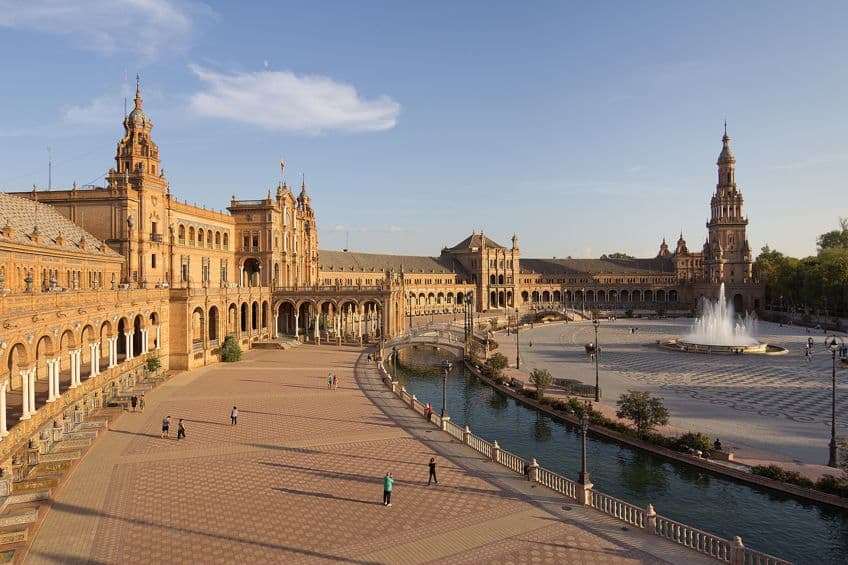
This plaza contains a variety of beautifully tiled alcoves, and these alcoves are representations of the various provinces in Spain. In addition, each of these small alcoves is full of books in the modern day. These books are about those provinces and are intended as a free library, and visitors can leave their own books. This plaza has become some of the most famous architecture in Spain. The Plaza de España has also since been renovated and this Spanish building is now used as office space for various government agencies. Some of the biggest buildings that form the plaza have also been converted into museums. This is a beautiful and illustrious part of Spanish architecture history and a jewel of the city of Seville.
Guggenheim Museum Bilbao (1993 – 1997) in Bilbao
| Architect | Frank Gehry (1929 – Present) |
| Date Constructed | 1993 – 1997 |
| Function | Museum |
| Location | Bilbao, Spain |
The modern-day architecture of Spain would be incomplete without a look at the Guggenheim Museum Bilbao. This famous piece of contemporary Spanish architecture was built beside the Nervion River as part of an attempt to somewhat rejuvenate the area around it. The plan worked, and this museum of contemporary art has become a major tourist destination. The site was designed by a non-Spanish architect, but the building has come to represent some of the most famous architecture in Spain in the modern day. This Spanish building was built with a galvanized steel structure that was then covered in titanium plates.
These various interconnecting pieces of titanium form the spectacular sight that can be viewed from the river and from above, although the street view is considered to be less gorgeous than the other angles.

This building may have become a major part of Spanish architecture history since its construction, but it has also actually become one of the most important pieces of modern international architecture. It has often been cited, by architectural experts, as one of the most important pieces of architecture between 1980 and 2010. It has been seen as one of the best examples of the Deconstructivism tradition, although the architect has renounced that label. The Guggenheim Museum Bilbao is the home to many changing art installations that are typically large-scale and/or site-specific. These art exhibitions are constantly changing and often revolve around some kind of a theme, but what cannot be disputed is that the architecture of Spain has never been the same since the construction of this famous art museum.
Marqués de Riscal Hotel (2003 – 2006) in Elciego
| Architect | Frank Gehry (1929 – Present) |
| Date Constructed | 2003 – 2006 |
| Function | Hotel |
| Location | Elciego, Spain |
The Marqués de Riscal Hotel is a luxury hotel located on a wine estate. It forms part of the Luxury Collection brand of hotels, and it may not appear like a particularly fantastic architectural sight if we view its relatively short height of 35 m, but the striking style of the building is what leaves many shocked to see it. This luxury hotel is part of the Marqués de Riscal wine complex, and so it’s a place to relax and enjoy proper wine in proper wine country. The area, Elciego, has been producing wine since 1858, so even though the building itself is relatively young, having only finished construction by 2006, it is still a stunning sight to behold.
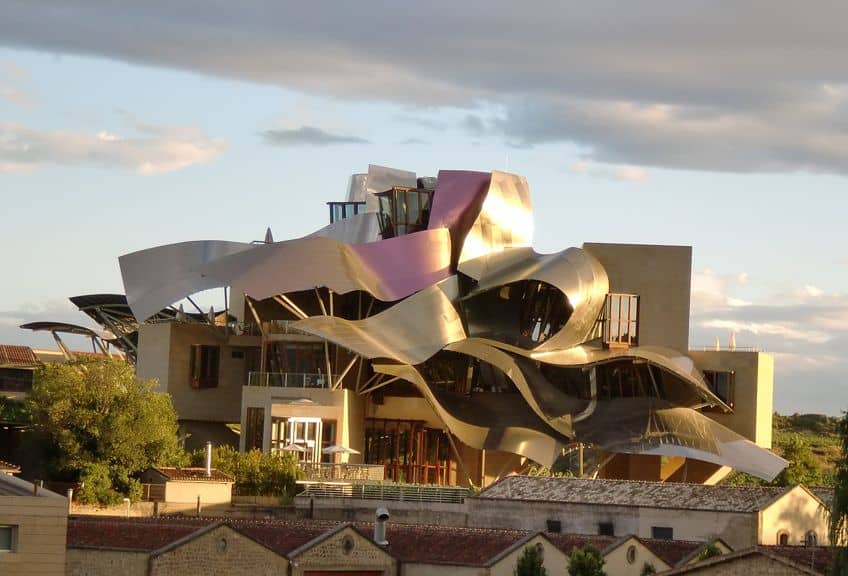
This Spanish building was designed by the same architect as the Guggenheim Museum Bilbao, and it is also partially based on it. It’s a mess of titanium plates in various colors that cover and loop around the strange-looking structure. It may not be what you’d considered traditional Spanish-style architecture, but its more famous museum cousin has shown that some of the latest innovations in international architecture can now be found in Spanish buildings.
And that has been our look at Spanish architecture through the years. This form of architecture was heavily influenced by early Roman intervention and then Christian and Islamic forms, but it managed to create an identity for itself through those forms. Today, Spain contains some of the most complex contemporary pieces of architecture in the world, and that may just continue into the future.
Frequently Asked Questions
What Are Some Spanish Styles of Architecture?
Architecture in Spain has been influenced by other forms over the centuries, but there are uniquely Spanish adaptations to more recognizable European forms, such as the Churrigueresque and Herrerian forms that were prominent around the Renaissance and Baroque eras in Spain.
Who Are the Most Famous Spanish Architects?
There have been many famous Spanish architects over the centuries. Some of them include people like Alonso Cano (1601 – 1667), who designed the Granada Cathedral, or Antoni Gaudí (1852 – 1926), who developed a highly personalized style in structures like the Sagrada Família. The modern era has also seen architects like Santiago Calatrava (1951 – Present) create intricate works like the City of Arts and Sciences in Valencia, and others around the world.
What Is Spanish Colonial Revival Architecture?
Spanish Colonial Revival architecture is a form of early 20th century architecture that is based on the Spanish colonial architecture found in the Americas during their colonization. This style is all over places like Florida and California in the United States. It is characterized by architectural features like stucco unadorned walls and terracotta shingles.
Justin van Huyssteen is a writer, academic, and educator from Cape Town, South Africa. He holds a master’s degree in Theory of Literature. His primary focus in this field is the analysis of artistic objects through a number of theoretical lenses. His predominant theoretical areas of interest include narratology and critical theory in general, with a particular focus on animal studies. Other than academia, he is a novelist, game reviewer, and freelance writer. Justin’s preferred architectural movements include the more modern and postmodern types of architecture, such as Bauhaus, Art Nouveau, Art Deco, Brutalist, and Futurist varieties like sustainable architecture. Justin is working for artfilemagazine as an author and content writer since 2022. He is responsible for all blog posts about architecture.
Learn more about Justin van Huyssteen and about us.
Cite this Article
Justin, van Huyssteen, “Spanish Architecture – Examples of Famous Architecture in Spain.” artfilemagazine – Your Online Art Source. April 24, 2023. URL: https://artfilemagazine.com/spanish-architecture/
van Huyssteen, J. (2023, 24 April). Spanish Architecture – Examples of Famous Architecture in Spain. artfilemagazine – Your Online Art Source. https://artfilemagazine.com/spanish-architecture/
van Huyssteen, Justin. “Spanish Architecture – Examples of Famous Architecture in Spain.” artfilemagazine – Your Online Art Source, April 24, 2023. https://artfilemagazine.com/spanish-architecture/.


